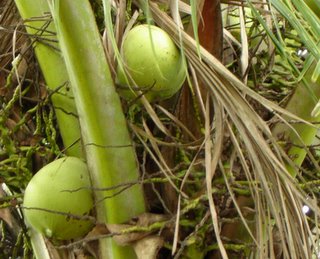So I was surprised to learn, during my first trip to Singapore back in 1989, that the brown hairy things are actually the innards!!
Coconuts growing on trees are more like cabbage-to-melon sized, and are smooth outside. And no, green, yellow, and brown are not necessarily different types of coconuts – they maybe different stages of growth, depending on the type of coconut. And even more astonishing, to me at least, they are edible at different ages!!
 The young green coconut is more a beverage than a food. The top is cut off (usually with a machete), and the liquid inside is clear and pure – one of the cleanest forms of water, with a very subtle flavor. After drinking the water, you can scoop out the jelly-like pulp. It has a similar flavor to the water, and is slightly sweet. On local menus, it is "kelapa muda" - young coconut.
The young green coconut is more a beverage than a food. The top is cut off (usually with a machete), and the liquid inside is clear and pure – one of the cleanest forms of water, with a very subtle flavor. After drinking the water, you can scoop out the jelly-like pulp. It has a similar flavor to the water, and is slightly sweet. On local menus, it is "kelapa muda" - young coconut. The yellow coconut also still has a significant amount of water, though it has a stronger flavor – and is not at all sweet. Again the top is cut off to get to the liquid. It is best served chilled, in the shell or in a glass, mixed with a little sugar and lime juice – much more refreshing than lemonade! And the pulp has matured and sweetened. It can be eaten as a fruit or dessert. The yellow coconut is also used in Balinese Hindu ceremonies.
The yellow coconut also still has a significant amount of water, though it has a stronger flavor – and is not at all sweet. Again the top is cut off to get to the liquid. It is best served chilled, in the shell or in a glass, mixed with a little sugar and lime juice – much more refreshing than lemonade! And the pulp has matured and sweetened. It can be eaten as a fruit or dessert. The yellow coconut is also used in Balinese Hindu ceremonies. The fully mature brown coconut on the right is almost dangerous – as they do fall from the trees when fully ripe! The smooth outer husk is removed, revealing the familiar brown, hairy baseball-to-softball sized coconut of grocery stores. This is the stage that produces coconut milk. NOT the little bit of liquid inside - that is coconut water and it’s not very nice. Coconut milk is made by shredding the pulp, or “meat”, of the coconut, mixing it with water to soak, and then squeezing out the resulting liquid. Sweetened, this is what gets added to pineapple juice to form the base of pina coladas. Unsweetened, it is used in various curries and in soups such as the Thai Tom Kha Gai.
The fully mature brown coconut on the right is almost dangerous – as they do fall from the trees when fully ripe! The smooth outer husk is removed, revealing the familiar brown, hairy baseball-to-softball sized coconut of grocery stores. This is the stage that produces coconut milk. NOT the little bit of liquid inside - that is coconut water and it’s not very nice. Coconut milk is made by shredding the pulp, or “meat”, of the coconut, mixing it with water to soak, and then squeezing out the resulting liquid. Sweetened, this is what gets added to pineapple juice to form the base of pina coladas. Unsweetened, it is used in various curries and in soups such as the Thai Tom Kha Gai.And, of course, if you just shred the coconut meat and sweeten it, you get a fresher version of what Grandma used on her coconut cake!

No comments:
Post a Comment